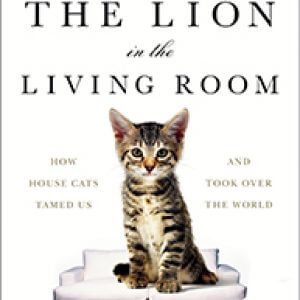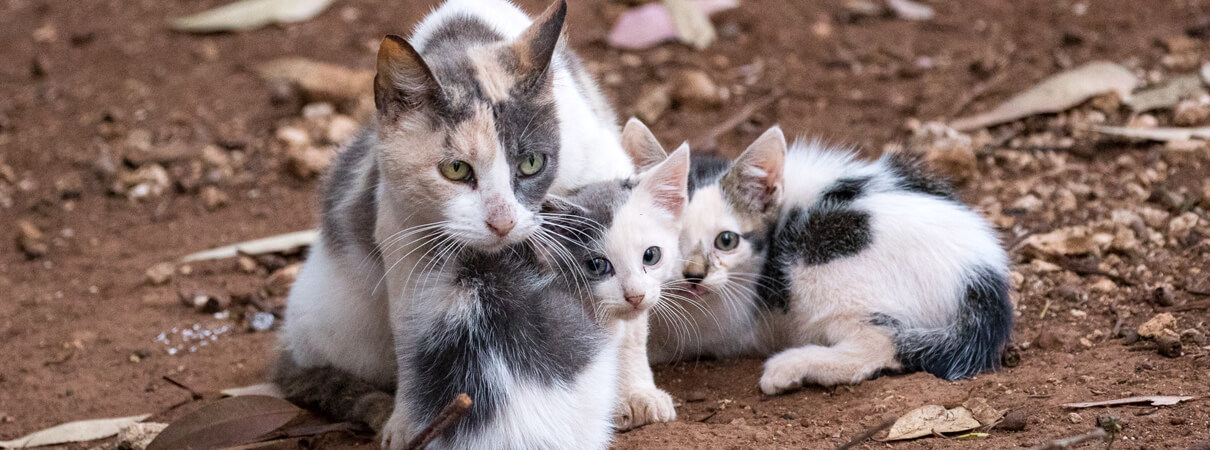Beloved and Deadly, Cats Are the ‘Lion in the Living Room'
What is it about cats? They purr and cuddle up to us on our laps. But they also hunt birds and small mammals to the brink of extinction — and beyond. Whether house cats are turning entire ecosystems upside down or starring in misguided attempts at rat control, one thing is consistently true: Cats rarely do what we expect of them.
 In her book The Lion in the Living Room: How House Cats Tamed Us and Took Over the World, author Abigail Tucker, a correspondent for Smithsonian magazine, explores the fascinating history of these “global overlords” from prehistoric times to the age of Instagram. Tucker recently answered a few questions from ABC about her book, which is now out in paperback.
In her book The Lion in the Living Room: How House Cats Tamed Us and Took Over the World, author Abigail Tucker, a correspondent for Smithsonian magazine, explores the fascinating history of these “global overlords” from prehistoric times to the age of Instagram. Tucker recently answered a few questions from ABC about her book, which is now out in paperback.
What role did your cat, Cheetoh, play in the development of this book?
Cheetoh, my furry orange muse, made me see these familiar pets as formidable life forms. The first striking thing about Cheetoh was his physique. At his peak, Cheetoh weighed more than 20 pounds. He used to alarm the cable guy and other workmen who stepped into my living room. His size forced me to see how much house cats look and even act like big cats, and so I started to wonder: why are there nearly a billion Cheetohs strolling the planet today when so many wild cats, like tigers and jaguars, are dying out?
Cheetoh's personality was even more astonishing than his actual size. His brazen bossiness helped me understand that the key to the domestic cat's staggering global success has much to do with the way they've adapted to human company over the millennia.
Cats are such a familiar part of our lives that many people don't realize they are an invasive species. Where did cats come from, and how did they spread to so many places?
House cats hail from the Near East, where a little over 10,000 years ago their wildcat ancestors sidled up to our firesides and slipped into our mud huts, helping themselves to our meat scraps. As early as 9,000 B.C., humans started toting cats along on sea voyages, possibly because we thought they would kill shipboard rats. So we ended up ferrying them everywhere. And once they reached a far-flung destination, cats were perfectly capable of jumping ship and fending for themselves, invading new ecosystems.
Cats are a rather unusual sort of invasive species. Most invasives are simple organisms like jellyfish or blackberry bushes that require only low-quality food and spread incidentally, without people really noticing. Cats, though, are charismatic hypercarnivores that demand a diet of high-quality meat and exist at the tippy-top of the food chain. It's rare that an animal with such finicky eating habits would be able to survive in alien environments, and that humans would intentionally chauffeur the invading critter around.

Photo by Carlos Restrepo/Shutterstock
So what happened once cats arrived at a new place?
Once cats have a paw in the door of a new ecosystem, they make their own luck. They are magnificent breeders and superb hunters that have no problem satisfying their high protein requirements by pouncing on anything in sight. Fluctuations in climate don't seem to bother house cats much. They can thrive in deserts or rain forests, on active volcano cones or sub-arctic islands where even many insects can't survive.
We're in thrall to house cats as pets. Domesticated or not, they're also super-predators. What makes cats so good at hunting?
All three dozen species of feline are standout hunters, from sand cats to clouded leopards, and house cats are no different. With their otherworldly hearing and eyesight and fabulous athleticism, they are quintessential stalk-and-ambush predators. Of course, house cats are especially formidable because they eat such a broad diet, including more than a thousand species, from grasshoppers to pelicans to wallabies. Some of their wild cousins, on the other hand, focus on only one type of prey animal – the Canada lynx, for instance, depends on snowshoe hares.
But I think a more complete answer lies in this tricky idea of domestication. Whether or not they technically live in houses, all house cats are domesticated animals. This applies to the stray cats of urban alleyways, the feral cats of Madagascar's interior forests, and plump and coddled specimens like Cheetoh. Some house cats are friendly, and some are feral and fierce, but all are domesticated.
What does it mean, exactly, for a cat to be domesticated?
It means their bodies and brains have gone through a permanent metamorphosis in human company. House cats have smaller brains than their wild counterparts, and the shrinkage seems to be in the part of the brain associated with fear. This inherited boldness helps cats, as hunters, perform in stressful environments — our cities and suburbs. Disturbances that discourage other predators don't necessarily bother house cats.
But there's a twist. Although house cats have these smaller brains, they lack other physical hallmarks of domestication that you see in most domesticated animals — like floppy ears, curly tails, and smaller teeth. Despite their personality changes, on the outside house cats don't look much different from wild cats. Scientists think that cats have only been domesticated to a degree, and that the process is still ongoing. This unusual semi-domesticated status may be another boon for cats as hunters. As cuddly as they can act, they seemingly haven't lost their wild hunting instincts to the extent that dogs and other household animals have.

Photo by Briana Hunter/Shutterstock
You mention in your book that cats cause “hyperpredation.” What is that, and what does it do to native ecosystems?
Hyperpredation sometimes happens when the number of predators in an environment is out of whack. Often, when ecosystems have large house cat populations, it's because humans have also introduced an invasive prey source for them.
For instance, 19th-century sailors sometimes released rabbits on remote islands so they could drop anchor there on the next voyage and enjoy a nice rabbit dinner. House cats disembarked on the same islands. The rabbits bred quickly, the house cats ate them to their hearts' content, and the feline population exploded. Meanwhile, the native birds and small mammals bred at the same rate as usual. Sustained by rabbits, the huge numbers of house cats gobbled as many native critters as they could catch – which is, unfortunately, quite a lot. Under normal circumstances, if a predator ate all the native prey in the environment, it would starve. But not if it can always snack on an invasive rabbit. In this way, humans help cats defy the laws of nature.
We create a similar situation when we feed pet cats canned food and then let them go out hunting. Cat populations don't reflect local prey populations. They reflect local can-opener populations.
Are species ever at risk of extinction from cat predation?
Absolutely. Cats can do tremendous damage, especially to island ecosystems, where they may contribute to or cause the extinctions of small mammals, birds, and reptiles. Carnivorous predators like house cats are rare on islands. Prey animals there may exhibit “island tameness” and lack defense strategies or even fear itself. Some scientists say that across the entire continent of Australia, feral house cats are more threatening to local mammals than habitat loss, which is staggering to contemplate. Hawaii — home to lots of rare, slow-breeding birds — suffers from similar problems. The effects on the American mainland are still being studied.
The use of cats to control urban rat populations has received attention in several cities recently. What did your research indicate about the effectiveness of such a strategy?
We all know that cats are marvelous killers. Why wouldn't they bump off a few rats for us? Perhaps they do dispatch a few, but there is little evidence that cats actually help control rat populations. Norway rats, the dominant pests of modern cities, are among the toughest beasts on the planet. They are one of the few critters that can go toe-to-toe with house cats as breeders and eaters.
I spoke with a scientist who spent years observing cat-rat interactions in Baltimore's alleyways. He found that cats, quite prudently, almost never attack the large, aggressive, disease-ridden street rats, and that the cats and rats coexist rather amiably, clustering around dumpsters to consume vast piles of trash. As a general rule of thumb, cats rarely do what humans want them to do, which is part of why we find them so fascinating.
What are your impressions of Toxoplasma gondii? Is it really a health concern?
Cats have infected an estimated one in three people worldwide, and perhaps 10 percent of Americans, with a single-celled brain-dwelling parasite called Toxoplasma gondii. The neurological impacts of this parasite are still being understood. In most healthy adults the feline-transmitted infection goes dormant after about a month. But a minority of people apparently have difficulty battling the disease from the beginning, and in these unlucky patients the infection has been associated with a whole cornucopia of health conditions, from schizophrenia to road rage.

A feral cat and kittens on the island of Oahu, in Hawai'i. Photo by Chris Farmer
Most people don't understand how the disease spreads. Obstetricians warn pregnant women not to scoop kitty litter boxes, for instance, because toxoplasmosis (which can be spread by direct contact with cat poop) is especially threatening to unborn babies. But indoor-only cats rarely carry the disease — it's outdoor cats eating wild prey that are typically the culprits. What's more, humans are also exposed to toxoplasmosis from eating unwashed vegetables (cats poop a lot in gardens) or rare meat at dinner.
The global spread of Toxoplasma gondii — by some measures, the most successful parasite on the planet today — is an absolutely amazing sci-fi twist in the house cat's story. It's the textbook example of the unexpected chain reactions that result from an act as innocent as joining forces with a cute little species of wildcat.
Where do you see our relationship with cats going in the coming decades?
House cat populations are exploding — rising at the rate of a million cats per year in some countries — in part because cats fit in perfectly with all the global lifestyle trends. Increased urbanization and an aging population both favor cats over dogs as convenient pets, and more pet cats means more strays. Culturally, our love affair with these animals is intensifying. We really don't seem to mind that they ignore rats and give us mysterious brain diseases. We are in awe of their beauty and charm. Although cats have wreaked havoc in some parts of the world, my appreciation for these animals, and their ability to survive in all circumstances, has only increased as I've learned more about them. And of course, house cats' recent invasion of the internet is both the same old story and the icing on the cake.
In a sense, I find it totally refreshing that humans are entangled in an interspecies relationship that we can't quite make sense of, and where we aren't necessarily in control. Humans are accustomed to using animals, especially domesticated animals, for cold, self-interested purposes, and for once that's not the case here. We increasingly see cats as furry family members or Instagram stars. But it's vital to remember that these are flesh-and-blood beings with an astounding and unique natural history — and that there are real-world consequences for their presence.
 | Abigail Tucker is a correspondent for Smithsonian magazine, where she covers a wide variety of subjects, from vampire anthropology to bioluminescent marine life to the archeology of ancient beer. Her work has been featured in the Best American Science and Nature Writing series and recognized by the National Academies of Sciences. Previously she was a reporter at The Baltimore Sun, where she won Columbia University's Mike Berger Award for feature writing and a National Headliner award. The Lion in the Living Room is her first book. |
 | Jennifer Howard is Director of Public Relations at American Bird Conservancy. She was a writer and reporter with The Chronicle of Higher Education for 10 years and before that was a contributing editor and columnist with The Washington Post. Follow Jen on Twitter at @JenHoward. |


















































